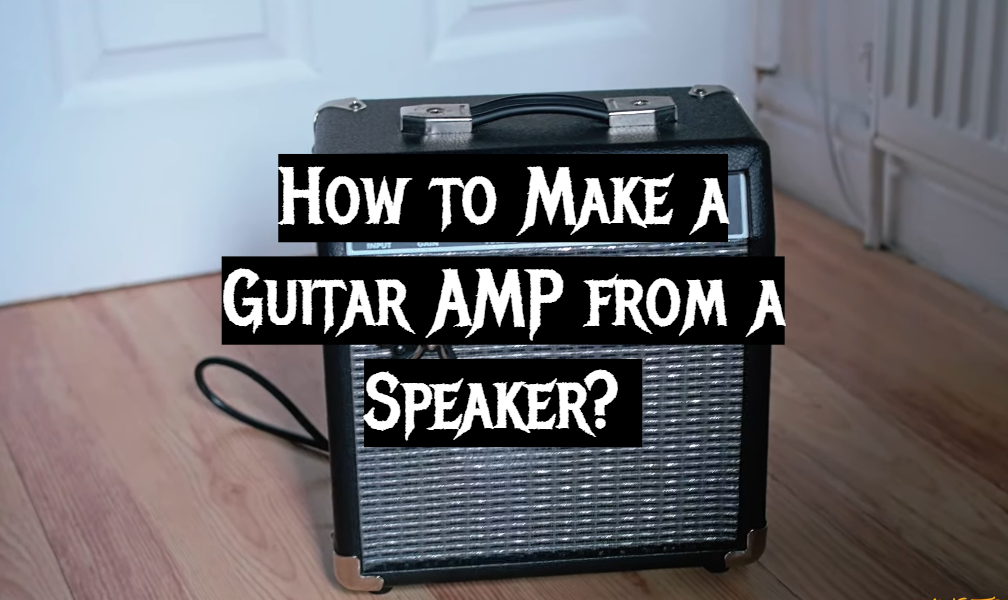Do you actually need computer speakers nowadays? You may still purchase them, but it seems that most people are no longer concerned about connecting external speakers to their computers through cables. When everything is Wi-Fi or wireless, why bother anyway? But do not hurry to throw the computer speakers under the bus, you may still use them. Especially if you need an AMP (amplifier) for your guitar.
You may buy a new speaker or invest in old computer speakers that can be found in most junk stores for a few bucks. Or just order from eBay. They should not cost over $10.
Table of Contents
Why does a PC speaker make a good guitar amp?
An amplifier is integrated into all of these computer speakers, which is how you can boost the volume. This hack enables you to connect your guitar to the speaker amplifier and play it via it. You may also change the audio input to connect your MP3 or iPhone player.
Additionally, hacking a speaker in this manner might provide you with the most incredible tone. You’ll be surprised by the unusual “lo-fidelity” sound that’s generated. This is a really easy hack that anybody with even the most basic soldering abilities can do.
How to make a guitar amp from a computer speaker:
Gather all necessary parts and tools:
- Cheap PC speakers;
- 1/4-inch mono jack connector (6.35 mm) for the guitar cord;
- Stereo jack female socket connector (3.5 mm);
- The male-to-male audio cable (3.5 mm);
- Heat shrink;
- Wires;
- Philips Head screwdriver;
- Soldering iron;
- Super glue;
- Hot glue;
Check the speaker
It is what is on the inside that matters rather than the type of speakers you have. In most situations, computer speakers come in pairs, with one serving as a speaker in an exterior shell and the other housing the amplifier. The one with the amp, which will include volume control and maybe an on/off switch, is the one you’re looking for. Perhaps you’ve also been endowed with bass and treble controls. The more the merrier, since this will allow you to obtain some unique sounds from your amplifier.
Pull the speakers apart:
- Remove the cover and unscrew the speaker casing. Make sure you don’t destroy anything inside. The front can be screwed on, but the remainder is bonded together;
- Store the screws and any other pieces in case you need them later;
- Remove the speaker and circuit board from the speaker’s body by unscrewing them;
Check the circuit board
Find 3 things on the circuit boards to hack them:
- Power. The first step is to determine where the circuit board’s power is linked. This is simple since you can either trace the wires from the adapter to the board or use the battery terminals if it is battery-operated. The positive wire is usually red, whereas the negative is black;
- Volume Potentiometer. To use a speaker to play guitar. Because it’s simply the volume knob, it’s simple to find. The solder spots on the potentiometer are what you need to look for;
- Jack (audio input). For using the speaker to play music. The male jack on PC speakers should be used to plug into the computer. You’ll find one of these at the wire’s end on every pair of headphones you have;
Add power
For the amp to operate, all PC speakers will require power. Some can only be powered by a wall power, while others feature both a battery and a wall outlet:
- You should be able to find the number of volts the speaker requires on the back of the speaker casing;
- Look for the power cables. Because the cables are generally red and black, they should be simple to spot. Cut the wire but leave the ends connected to the board after you’ve found the power wires. You don’t need to re-solder onto the circuit board this way;
- Then solder the 9-Volt battery holder to the amp’s positive and negative wires;
- Remember to use heat-shrink on the solder spots;
Whether your amplifier has an on/off LED indicator, tell whether it’s on by turning it on and checking if the LED lights up. If not, you should double-check your wiring.
Add a female socket connector
A male audio input jack is found on most, if not all, computer speakers. Typically, this is a wire that emerges from the speaker. You could simply leave this as is and use it to plug into your iPhone if you wanted to:
- Turn up the volume (the battery should be in place);
- Connect one end of the 3.5mm audio cable to your iPhone or whichever device you use to listen to music. Start listening to music on your iPhone;
- Plug the opposite end of the audio cable into the Stereo Jack Female Socket Connector;
- Touch the solder points on the connector with the wires that used to be connected to the input jack. If no music comes out of the speaker, try a new combination until you do;
- Solder the wires to the connector’s solder points;
Add the female jack to the amplifier
We can skip forward to this part since you’ve already found the sections you need (negative terminal and potentiometer). This isn’t a difficult task.
On the 1/4-inch jack connector, solder a black and red wire together. The red wire must be attached to the jack’s top solder point (which is attached to the arm that meets the male cable’s end). The black (the negative one) wire connects to the other solder point (which is attached to the jack’s side and contacts the male cable’s side).
Solder the black wire to the circuit board’s negative solder point. Remember, here is where the power’s negative wire is linked. However, if you’re having difficulties soldering onto this pint, follow the traces on the board from the negative point and apply an alternative negative solder point.
You need to plug the cord into the jack and the guitar
Make sure the speaker is turned on and strum your guitar. At the same time, connect the red wire to one of the potentiometer’s solder points and listen for any sound coming from the speaker. If it doesn’t work, try a different solder point.
Related Reviews:
You’ll eventually locate one (there are 3 to 6 solder locations on the potentiometer) where you can hear the guitar through the amplifier. However, it’s critical to test all of the solder spots to ensure you locate the finest one. Just because you can hear something doesn’t imply it’s the best spot for soldering the wire. Solder the red wire to the proper solder spot after you’ve discovered it.
Attach the jacks to the speaker
After you’ve soldered all of the female jack connections in place and checked everything, it’s time to drill a few holes in the speaker’s side and attach them:
- Decide where you need your jack connections to go. Keep in mind that you’ll need to reinstall the speaker, so ensure you have enough spot;
- Drill holes for the audio jack and the guitar jack connector;
- Secure them;
Close up the speaker
The last step is to seal the speaker case and double-check that all is in its proper location. There is no specialized battery space in the speaker if it was initially powered by electrical power. Simply stand the battery inside the speaker and seal everything up in this case. Disconnect the front of the case and unscrew the speaker to replace the battery.
Now that you’ve finished your amp/speaker, it’s time to put it through its paces on the guitar and see what kind of sound you get.
FAQ
What is the difference between a guitar AMP and a bass AMP?
Guitar and bass amplifiers are two very distinct types of gear, each intended to maximize the performance of its particular instrument. A guitar amp can’t replicate the bass guitar’s very low frequencies, while bass amps make guitars feel lifeless and dull. A dedicated guitar amplifier will provide better tones and motivate you to practice more.
What is the best size of a guitar amp for practicing?
When you’re first learning to play the guitar, a tiny practice amp is usually all you’ll have to get started. These amps are particularly ideal for musicians that need to travel for any reason, whether on the road or to their next practice, due to their reduced size.
There are many misunderstandings about how much power a guitar amplifier needs. The majority of “pro” amplifiers are between 30 and 100 watts. When you increase the amount of watts, the volume does not double. Only 5 decibels separate a 30-watt amp from a 100-watt amp.
What are the best speaker configurations for a guitar amp?
Impedance and the wattage of the amp are 2 major elements to consider when picking your speaker arrangement. One, two or four 12-inch speakers are all popular speaker combinations. A couple of 12-inch speakers will be enough for most concerts. Remember that your amplifier will most likely be linked to the PA system.
What guitar amps are good for playing live?
Most venues now put mikes on the amps to control better the sound that the crowd hears, thus massive amps are no longer necessary. You’ll almost always have stage monitors that will give sound. The only real concern is being capable of competing with the drum set’s inherent loudness. In most instances, 30–50 watts of power is all you’ll need to perform live. For live events, a cab with a couple of 12-inch speakers should be enough.






Leave a Reply